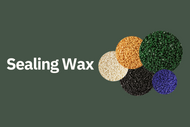Sealing Wax
31st Oct 2023

Instructions for the use of beaded bottle Sealing Wax
Wear Safety Glasses at all times. Hot Wax can cause serious burns if it comes in contact with skin.

- Scoop a small amount of Beaded Bottle Sealing Wax into a melting pot. For small quantities a "crock pot" is an ideal choice.
- Heat the wax gently until it starts to melt. When there is a layer of liquid wax covering the bottom of the pot add more wax in stages until you have sufficient wax to dip bottles.
- Use a thermometer to check the temperature before dipping, an ideal temperature range is 78°C - 88°C, depending on the thickness required.
- Metallic colours need an occasional stir to prevent the separation of metallic pigments.

- Ensure the bottle being dipped is corked/capped tightly.
- Ensure there is no liquid residue around the neck of the bottle.
- Lower the bottle vertically (upside down) into the wax as far as required. The wax must be far enough down the neck of the bottle to give an adequate seal.
- Do not leave the bottle in the wax too long.
- Remove the bottle at a slight angle to allow excess wax to drip back into the pot. Continuously rotate the bottle whilst lifting it out of the wax. Do this until the wax stops dripping.
- For a satin finish: Stand the bottle upright and leave to cool.
- For a glossier finish: Immediately dip the waxed bottle into cold water after removing from wax pot. The water will need to be changed as it warms.

To remove wax from dipped bottles:
- Make a diagonal cut in the wax from the bottom of the seal to the top edge.
- Lift the bottom edge and peel the wax away using your thumb.
- The wax should peel off in one piece, on most bottles.

- Why isn't the wax easily peeling off the bottle?
This is likely due to the wax coating temperature being too hot.
- Why does the wax colour look faded?
This is commonly caused by overheating the wax.
- What do I do if there are bubbles in the wax at the cap or cork seal?
This is caused by trapped air, either in the cork or in a cap ridge, expanding due to the heat of the wax. To minimise this problem, hold the bottle in the wax until bubbling ceases. However, some corks are very porous, and a satisfactory result can only be achieved by a second coat. The first coat must be cool before completing the second dip, and the second coat needs to be a quick dip.

